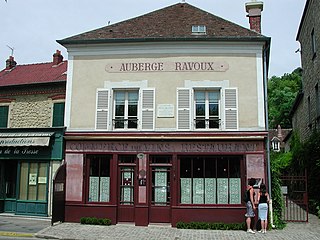
Vincent Willem van Gogh was a Dutch Post-Impressionist painter who is among the most famous and influential figures in the history of Western art. In just over a decade he created approximately 2100 artworks, including around 860 oil paintings, most of them in the last two years of his life. They include landscapes, still lifes, portraits and self-portraits, and are characterised by bold, symbolic colours, and dramatic, impulsive and highly expressive brushwork that contributed to the foundations of modern art. Only one of his paintings was known by name to have been sold during his lifetime. Van Gogh became famous after his suicide at age 37, which followed years of poverty and mental illness.
The year 1890 in art involved some significant events.
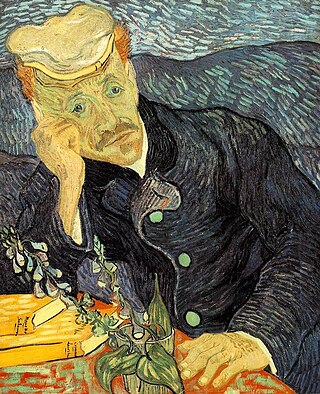
Portrait of Dr. Gachet is one of the most revered paintings by the Dutch artist Vincent van Gogh. It depicts Dr. Paul Gachet, a homeopathic doctor and artist with whom van Gogh resided following a spell in an asylum at Saint-Rémy-de-Provence. Gachet took care of Van Gogh during the final months of his life. There are two authenticated versions of the portrait, both painted in June 1890 at Auvers-sur-Oise. Both show Gachet sitting at a table and leaning his head on his right arm, but they are easily differentiated in color and style. There is also an etching.

Paul-Ferdinand Gachet was a French physician most famous for treating the painter Vincent van Gogh during his last weeks in Auvers-sur-Oise. Gachet was a great supporter of artists and the Impressionist movement. He was an amateur painter, signing his works "Paul van Ryssel", referring to his birthplace: Rijsel is the Dutch name of Lille.
Vincent van Gogh lived during the Impressionist era. With the development of photography, painters and artists turned to conveying the feeling and ideas behind people, places, and things rather than trying to imitate their physical forms. Impressionist artists did this by emphasizing certain hues, using vigorous brushstrokes, and paying attention to highlighting. Vincent van Gogh implemented this ideology to pursue his goal of depicting his own feelings toward and involvement with his subjects. Van Gogh's portraiture focuses on color and brushstrokes to demonstrate their inner qualities and Van Gogh's own relationship with them.
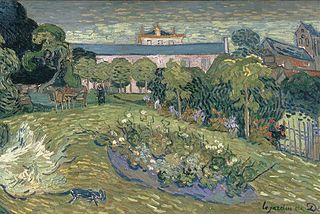
Daubigny's Garden, painted three times by Vincent van Gogh, depicts the enclosed garden of Charles-François Daubigny, a painter whom Van Gogh admired throughout his life.
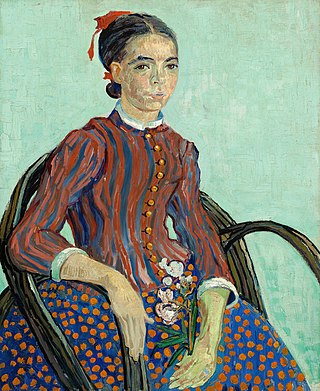
La Mousmé also known as La Mousmé, Sitting in a Cane Chair, Half-Figure was painted by Vincent van Gogh in 1888 while living in Arles, which van Gogh dubbed "the Japan of the south". Retreating from the city, he hoped that his time in Arles would evoke in his work the simple, yet dramatic expression of Japanese art.

Wheat Fields is a series of dozens of paintings by Dutch Post-Impressionist artist Vincent van Gogh, borne out of his religious studies and sermons, connection to nature, appreciation of manual laborers and desire to provide a means of offering comfort to others. The wheat field works demonstrate his progression as an artist from the drab Wheat Sheaves made in 1885 in the Netherlands to the colorful and dramatic 1888–1890 paintings from Arles, Saint-Rémy and Auvers-sur-Oise in rural France.

Vincent van Gogh enjoyed making Paintings of Children. He once said that it's the only thing that "excites me to the depths of my soul, and which makes me feel the infinite more than anything else." Painting children, in particular represented rebirth and the infinite. Over his career Van Gogh did not make many paintings of children, but those he completed were special to him. During the ten years of Van Gogh's career as a painter, from 1881 to 1890, his work changed and grew richer, particularly in how he used color and techniques symbolically or evocatively.

Dr. Gachet's Garden in Auvers and Marguerite Gachet in the Garden were both painted in 1890 by Vincent van Gogh in the gardens of his homeopathic physician, Dr. Paul Gachet. Both paintings reside at the Musée d'Orsay.

The death of Vincent van Gogh, the Dutch post-Impressionist painter, occurred in the early morning of 29 July 1890, in his room at the Auberge Ravoux in the village of Auvers-sur-Oise in northern France. Two days earlier, Van Gogh shot himself.
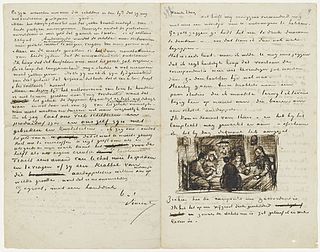
The Letters of Vincent van Gogh is a collection of 903 surviving letters written (820) or received (83) by Vincent van Gogh. More than 650 of these were from Vincent to his brother Theo. The collection also includes letters van Gogh wrote to his sister Wil and other relatives, as well as between artists such as Paul Gauguin, Anthon van Rappard, and Émile Bernard.

Old Vineyard with Peasant Woman is a watercolour painting by Vincent van Gogh that he made in May 1890 when he lived in Auvers-sur-Oise, France.

Houses at Auvers is an oil painting by Vincent van Gogh. It was created towards the end of May or beginning of June 1890, shortly after he had moved to Auvers-sur-Oise, a small town northwest of Paris, France.
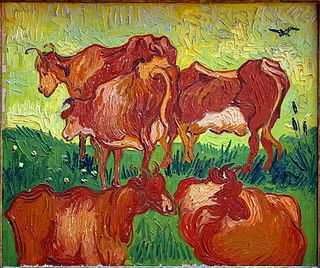
The Cows is a painting by Vincent van Gogh, produced in July 1890 during his stay in Doctor Gachet's home in Auvers-sur-Oise. It is based on an 1873 Paul van Ryssel etching Gachet owned of Jacob Jordaens's Study of Five Cows, exhibited in the Palais des Beaux-Arts de Lille.

Marguerite Gachet was a French woman who was painted by Vincent van Gogh in two paintings.

Rain is an oil-on-canvas painting by Vincent van Gogh, created in 1889, while he was a voluntary patient at an asylum in Saint-Rémy-de-Provence. He repeatedly painted the view through the window of his room, depicting the colours and shades of the fields and hills around Saint-Rémy as they appeared at various times of day and in varying weather conditions. Rain measures 73.3 cm × 92.4 cm and is held by the Philadelphia Museum of Art in the United States.

Wheatfield Under Thunderclouds is an 1890 oil painting by Vincent van Gogh. The painting measures 50.4 cm × 101.3 cm. It depicts a relatively flat and featureless landscape with fields of green wheat, under a foreboding dark blue sky with a few heavy white clouds. The horizon divides the work almost into two, with shades of green and yellow below and shades of blue and white above. Since 1973 it has been on permanent loan to the Van Gogh Museum in Amsterdam.
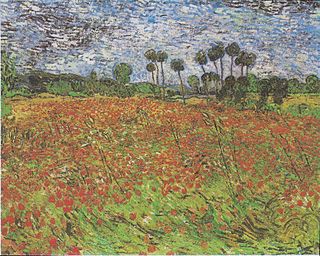
Poppy Field is an 1890 painting by the Dutch artist Vincent van Gogh, painted around a month before his death during his stay in Auvers-sur-Oise, France. It has been described as "a composition that verges on the abstract" and shows marked difference from a 1888 painting of the same subject that now is in the Van Gogh Museum, in Amsterdam. Spending many years in Germany, the painting now hangs in the Kunstmuseum, in The Hague.







